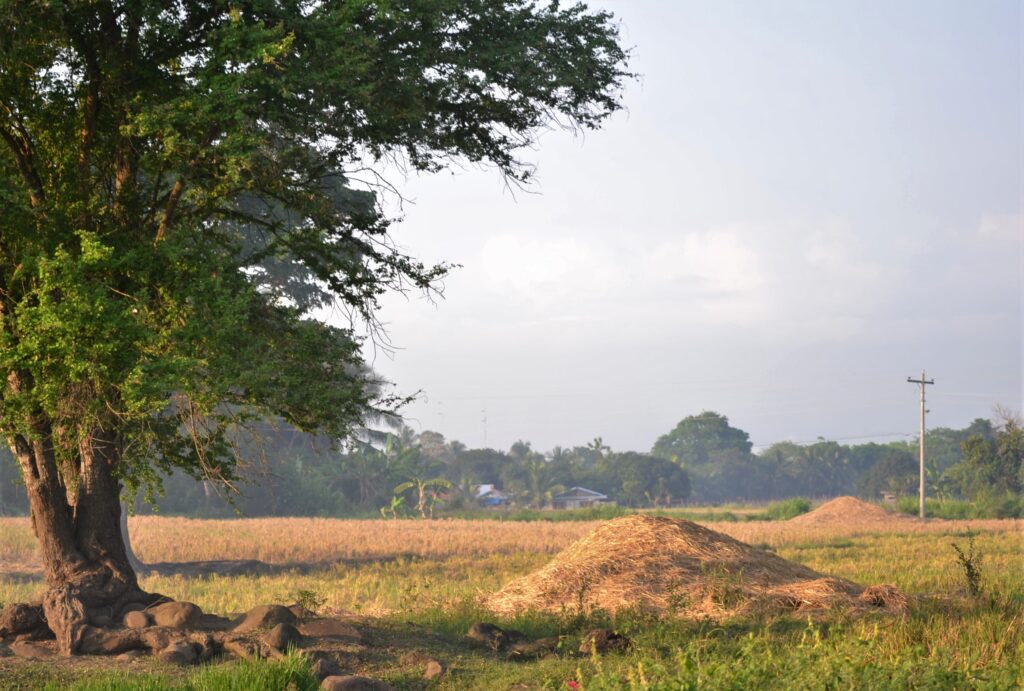Text and Photos by Henrylito D. Tacio
In producing rice, one of the wastes that are left in the open field after harvesting are the rice straw, locally known as dayami.
Rice straw is a rice by-product produced when harvesting paddy. “Each kilogram of milled rice produced results in roughly 0.7 to 1.4 kilograms of rice straw depending on varieties, cutting-height of the stubbles, and moisture content during harvest,” explains the International Rice Research Institute (IRRI). “Rice straw is separated from the grains after the plants are threshed either manually, using stationary threshers or, more recently, by using combine harvesters.”
Most of these rice straws are simply disposed of – by burning. Unknowingly, not too many Filipino farmers are aware that burning rice straws can contribute to global warming, experts claim.
“Burning of rice straws, generally practiced during the harvest season, causes air pollutants such as carbon dioxide, carbon monoxide, nitrogen oxide, and Sulphur dioxide,” the Nueva Ecija-based PhilRice said in a press release. All those pollutants are considered greenhouse gases (GHGs), which are responsible for trapping the heat from the sun as it radiates back into space.
As such, burning rice straw is not environment-friendly. In addition, it is also unhealthy. Studies have shown that rice straw burning is also known to emit particulate matter and other chemicals such as dioxins and furans that have a negative impact on human health.
A study conducted by the Department of Science and Technology (DOST) said that uncontrolled open burning, the highest percentage of which entailed burning of agricultural waste like rice straws, is the highest source of carcinogenic dioxins and furans – which are emitted during the combustion process.
Unknowingly, there are several uses of rice straw, according to PhilRice. “To minimize postharvest waste, rice straws can be used by farmers as organic fertilizer and primary material for mushroom production,” it suggests.

Rice straw 
Rice straw left after harvesting
Rice straw and other biomass from farm by-products can help farmers save expenses from chemical fertilizer inputs. Recycling farm wastes can also keep their environment clean and free from pollutants.
“When straws are scattered in the field during land preparation, they maintain soil’s nutrients and moisture,” said Evelyn J. Javier, PhilRice’s supervising science research specialist of the Agronomy, Soil, and Plant Physiology Division.
According to Javier, every 5 tons of rice straws can increase soil’s nutrients such as nitrogen, phosphorus, potassium, sulfur, silicon, and carbon. They also preserve the biological diversity of microorganisms that helps in nutrient cycling and efficient fertilizer utilization.
Rice straw can also be used as mulch to protect the roots of the plants from heat and cold and reduce the evaporation rate. They also prevent weeds from growing in the paddy field.
At the Mindanao Baptist Rural Life Center (MBRLC), a non-government organization in Kinuskusan, Bansalan, Davao del Sur, rice straws are used as mulching materials for the vegetables they produce. These are placed under the growing tomatoes, sweet pepper, eggplants, cucumbers, and ampalaya.
Another profitable use for rice straws is in mushroom production. “Rice straw can be used as the basic material for mushroom cultivation,” said the website businessdiary.com.ph. “Mushroom are capable of breaking down organic material that other microorganisms cannot decompose.”
Rice straw can be used as the main substrate. However, the rice straw must be composted first. To improve the nutrient content, rice straws are mixed with chicken manure, rice bran, urea, and gypsum. For each ton of dry rice straw, 100 kilograms of chicken manure, 50 grams of rice bran, 12-15 kilograms of urea, and 10 kilograms of gypsum are added.
Growing mushrooms on rice straw can help break down the straw making it more suitable for anaerobic digestion, says Craig Jamieson, a bioenergy expert. Anaerobic digestion, he adds, produces biogas, which can, in turn, be used as an alternative energy source for cooking, generating heat for drying, and producing electric power.
The waste from mushroom production is also the main substrate for vermicomposting, one of the best organic fertilizers produced. At the Lao Integrated Farm, Inc. in barangay Eman in Bansalan, Davao del Sur, rice straws are utilized as “feed” for the earthworms that turn them into vermicompost.
Rice straw can also be used as silage for cattle feed. “Rice straw has too few nutrients to be used as the only source of food for cattle but is a good feed additive and can also be treated to increase the supply of energy and protein,” said Dr. Martin Gummert, senior scientist at IRRI’s Postharvest Development.
“In general, the daily recommended maximum intake of rice straw by ruminants is 1 to 1.5 kilograms per 100-kilogram live-weight per day,” he continued. “Urea-treated straw (rice straw is ensilaged with 2-3% urea) can increase intake and digestibility of this rice straw-based feed.”

